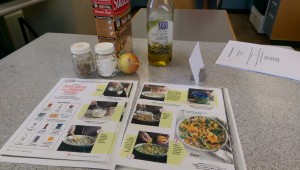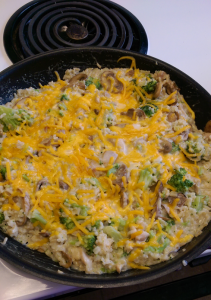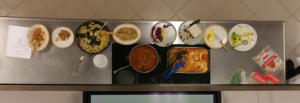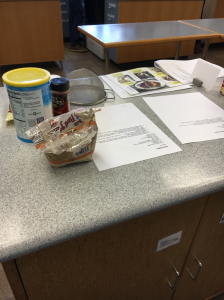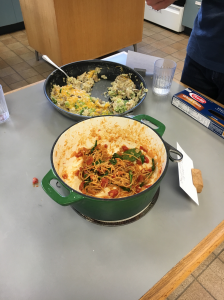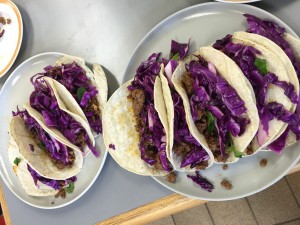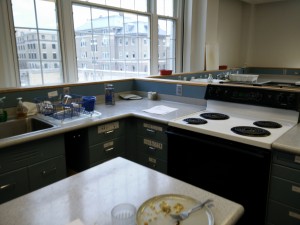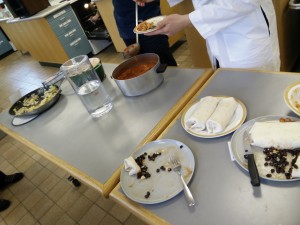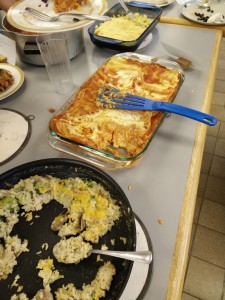Last Saturday I, along with other Rose Scholars, had the opportunity to attend a cooking class– and it was probably my favorite Rose House event thus far! Emily Gier, of the Human Ecology school, taught us all basic knife work skills and cooking 101, like how to properly cut an onion and set up mise en place. After a few quick tips, we were off on our own to make our own dishes. Initially, I was pretty nervous. I absolutely love baking, in fact my sister and I actually have a cookie company! However when it came to “real” meals, I’m seriously lacking experience. Thankfully, there were plenty of assistants to help us all out. My dish was a spinach and tomato one pot pasta. When the dish was finished, I couldn’t believe that I had made it, and people were actually eating it! The beauty of one pot dishes is that there minimal clean up and they’re usually pretty simple without lacking in flavor. I’ve already planned to make this exact dish back at home and hopefully learn more one pot recipes!
Category Archives: Cooking Workshop 2/20/16
Cooking Made Easy
Last Saturday, I went to the cooking workshop to learn some useful cooking skills for the future. I sort of wished we could have worked on more dishes, but I know there were some that were very involved. The first thing I found really useful was learning how to chop an onion. Whenever I cook for myself, I don’t particularly care what it looks like, so I just use a knife to get the food into edible pieces. Unsurprisingly, this isn’t the best way to prepare food. You want to cook food that’s about the same size, because then you’re able to get a more even cook. So Professor Gier demonstrated how she chops onions, by cutting a sort of blooming onion like lattice before chopping it into individual pieces. I actually got to try this with the dish that I made, but with a small onion, it didn’t turn out as nicely as the demonstrated onion.
When we split up into the different stations, I was immediately attracted to the chicken, broccoli and brown rice casserole, because I knew I liked all of the ingredients, and they are pretty common and inexpensive items. Looking back, I might have chosen something else just to try working with different foods I wouldn’t normally buy for myself. The recipe called for boiling brown rice in a bag and microwaving broccoli, which I had never had experience with.
Some of my starting ingredients
My Final Product
After the food was cooked, the food was placed out for everyone and we all tasted the different dishes. The biggest surprise for me was the avocado omelet. I had never really liked the taste of avocado, but its fattiness worked really well with the egg. Another dish I really enjoyed was the salmon (which I guess others liked a lot as well, because it was the one dish that was completely eaten when we reconvened at the end.
Once we had a chance to taste the food, there was a brief discussion about all of the foods and some questions people had about nutrition in general. I learned that those eggs in cartons are actually real eggs, and perfectly healthy. One thing I thought about afterwards that I didn’t get to ask, was whether there was an easy dairy-free substitute for the white sauce. Overall, I had a great time cooking and enjoyed a nice meal with the other Rose Scholars. I will definitely check out some more recipes from Cooking Light magazine in the future, because they were simple and came with lots of pictures to help.
Remnants of our cooking
Cooking is Fun
Last Saturday I had the opportunity to do the thing I miss most about being home, cooking. Sure I wasn’t cooking in my kitchen but it still felt like a piece of home. When we first arrived, we learned a few cooking techniques like how to cut an onion or make biscuits. Being a somewhat avid cook, I already knew most of the information. After breaking up into our own stations, I went to the omelet station. I made avocado and bacon omelettes which actually turned out very well. House Fellow Emily Gier, who teaches Food for Contemporary Living in the College of Human Ecology, gave me great tips, like not flipping or folding the omelette until you are plating the food. After getting to taste all the amazing and healthy dishes other people made, we reconvened to talk about healthy substitutions and products we, as college students, can use. For instance, I learned that beans are a great source of fiber and protein, and to make them even healthier, you should rinse the can of beans under water to get rid of about 40% of sodium. Simple, cheap substitutions and little techniques can greatly improve the nutritional value of foods one eats. Eating healthy is so important because it give one the energy needed to study and stay active!
Sometimes Healthy Food is more than just Veggies
Last week, I learned how to cook. Yes–you read that correctly. Me, a 19-year-old college student who voluntarily eats dry cereal at home just so I don’t have to wash my bowl, prepared soy sauce/ginger/garlic seared salmon with a side of veggie quinoa. It’s true. Yes. Honestly, I’d love to tell you that I spent an hour perfecting the dish and cutting the vegetables. But, this entire meal took me a solid 25 minutes to make, including the time it took me to cut the onions, celery, and walnuts. It turns out that fish cooks really quickly and you can literally just throw quinoa in a bowl of water for 15 minutes and leave it alone. Here’s a picture of my workstation!
See if you can read the recipe…. Hehehe it’s a secret! No, I’m just kidding. Feel free to leave a comment on this post and I’ll give you the recipe!
And everyone prepared dishes too, so our entire meal tasted AMAZING. Big shoutout to the people who made the lasagna and the casserole: it was phenomenal. Unfortunately, I was too excited about all the food to take a picture before I ate it, but here are some of the remnants.
Here’s a one of the one-pot pasta (yes, fewer dishes to wash!!) and the broccoli + mushroom casserole. Healthy, quick, easy, delicious.
And here are my salmon + quinoa dishes! Or…well, what they used to be. That yellow plate houses the very last piece of salmon. There are also some really amazing looking tacos and omelets in this picture too. All the food went really quickly and was so yummy; honestly I’m pretty proud that I remembered to take pictures in the first place.
In all seriousness though, this food was so easy to make. I think that’s really important because we’re all college students are we’re going to be entering the real-world pretty soon. We have to learn how to feed ourselves because there’ll come a day when we can’t use our BRBs to buy a quick snack before class. I highly recommend looking into meals like these (everyone who attended this event has a whole packet of recipes, so if there’s anything you’re interested in, just let one of us know!); cooking isn’t nearly as intimidating as it seems.
A Delicious Afternoon
Last weekend I attended the cooking workshop given by Professor Emily Gier. It was my first time in a food lab, and actually the first time I experienced cooking with a recipe. We were first given a demonstration of how to prepare and cook a few basic items, such as biscuits and omelettes. Both were surprisingly simple and quick. Professor Gier emphasized safety and hygiene when showing us how to properly chop an onion and reminding us not to cross-contaminate different foods. It felt a bit like being the audience of a cooking show with the demo kitchen at the front of the class, complete with a large mirror from above.
We then dispersed around the lab and each chose a recipe to complete within the next hour or so. Mine was beef tacos with cabbage slaw, which was simpler to make than I expected. Working with a partner, we chopped, mixed, and cooked until we had the finished product depicted below.
Since each of us made a different recipe, we got to sample all of them and critique one another’s cooking. All the dishes came out looking fantastic, and some in particular were very good. What was great about this workshop was that it focused on healthy, but quick, meals that could be realistically made for brunch or dinner in a Collegetown apartment setting. Realizing that many students will be living on their own, if not next year, at some point in the near future, this workshop took into account the needs and wants of busy students, inspiring us with new cooking ideas and empowering us with the knowledge that we can cook more more than just the basics.
Cooking Workshop, or what I like to call Lunch
On Saturday, instead of eating a full lunch, I met with some other Rose Scholars in the Rose lobby at 12:30 to walk up to MVR for this special cooking workshop. A couple of my friends were TAing the event, so I was really looking forwards to it. We’d received an email from Lou ahead of time with some of the recipes we might get a chance to make, and a bunch of them seemed interesting.
When we arrived, we got introduced to Rose House fellow Emily Gier, who teaches the food labs for the Nutritional Sciences major, as well as the TAs for the day. She spoke with us about what she teaches in the school. She then started demonstrating how to make some biscuits and omelettes. At this point, I was wowed by the way the classroom was set up. There were cooking stations on either side of the long room, and in the middle there was the demo station for the professor in front of a few rows of seats. But what really wowed me was the mirror above the demo station so we could see what the professor was doing on the stove. She started by explaining how to chop an onion, and then explained the difference between chopping, mincing, and cubing something to cook it. Then we got to see how she made biscuits, and then how to make an omelette. Apparently, for omelettes, you need to be really careful about how hot the stove is, because the egg can easily cook too quickly.
At this point, we split off to make different recipes. I wandered for a bit, looking at different recipes to see what I wanted to make. I was hesitant about making some things, because I wouldn’t be able to eat much of it due to dietary restrictions, but I ended up making the lasagna, with help from Sarah. I’ve never made a real lasagna, but I have made similar dishes before at home, so it wasn’t so strange to me. I started by chopping up some mushrooms and then sauteing them until they were tender. Sarah worked on the cheese mixture, an amazing mixture of ricotta, mozzarella, and Parmesan cheeses with some green mixed into it, and an egg. After my mushrooms were tender, I added the tomato sauce and water, which cooked until boiling. At that point, we began layering the lasagna — sauce, noodles, cheese, sauce, noodles, cheese, sauce, noodles, cheese, sauce. Then we covered it in tin foil and put it in the oven for 40 minutes.
At that point, several other people had finished making their creations, and they were being placed out on the center tables for us to try. There were egg and bean and salsa burritos, a turkey (sausage) chili, a chicken broccoli and rice casserole, a one-pot pasta, a salmon with quinoa stuffing, and many more options.
I tried lots of food at this point, while waiting on the lasagna. All of the recipes seemed rather easy to make, which was part of the point of this activity — to remind us that we can all cook and do it well, with just a little bit of work. After an hour or so, the lasagna was finally ready, and it tasted pretty good!
At the end, Professor Gier spoke with us about how we all did a good job, and explained some of the recipe picks. All of these (except for the lasagna and a couple other recipes) were meant to be quick meals, something we might be able to make ourselves after getting home from work or something. At the end of the day, I decided that I had to take the nutritional sciences food lab class where they learn how to make healthy meals with substitutions. I’m sure I could use the help learning how to cook healthier, and I love cooking so much.
A lab where you’re allowed to eat the experiment
Who knew we had a lab devoted to cooking at Cornell? I had no idea!
At the cooking workshop event this afternoon, we walked to a lab in MVR and then got to work baking, sautéing, chopping, and mixing as we put together 10 simple dinners. The workshop was meant to give us some ideas of easy and cheap dinners to make when we no longer have a meal plan, and we cooked up quite a variety of dishes. Included in the menu were salmon filets with ginger-garlic soy sauce and quinoa stuffing, beef chorizo tacos with cabbage slaw, stir-fried tilapia, dill and scallion lettuce wraps, among other deluxe but easy-to-make meals.
I absolutely love to cook, so this Rose Scholars event was my favorite one so far. I find cooking relaxing and fun, but I rarely have a chance to make anything during the semester. In addition to the hands-on part of the workshop where my partner and I made beef chorizo tacos with cabbage slaw, I also learned a couple new cooking skills. Prof. Emily Gier demonstrated the best way to chop an onion so that the pieces are the same size, how to ensure that biscuits are the right texture, and how to make the perfect omelette.
This event was the highlight of my week, and I look forward to making some of the recipes when I’m here over the summer.

